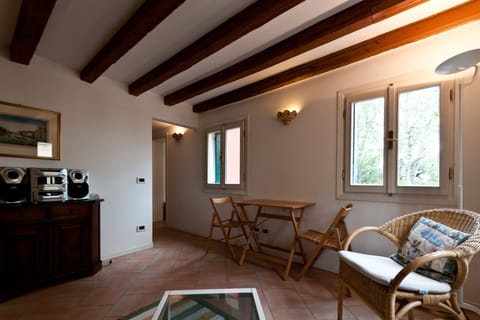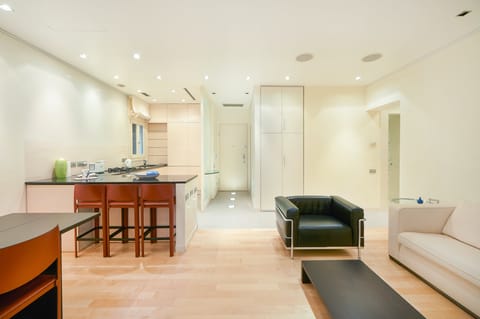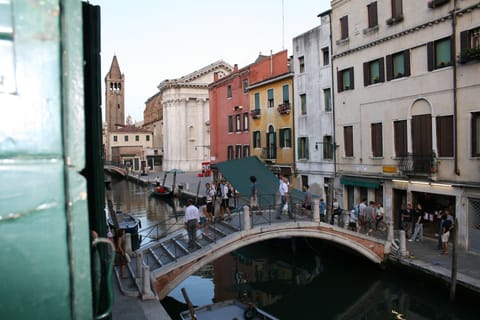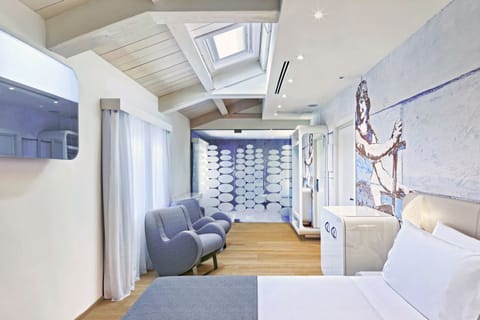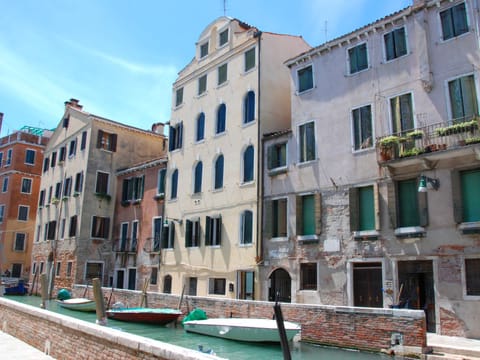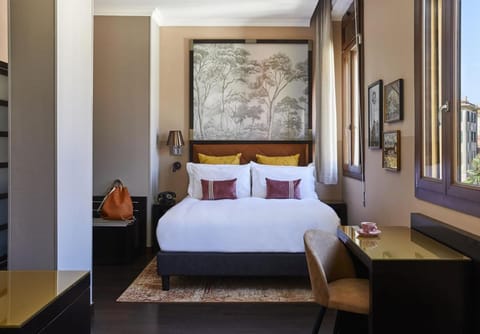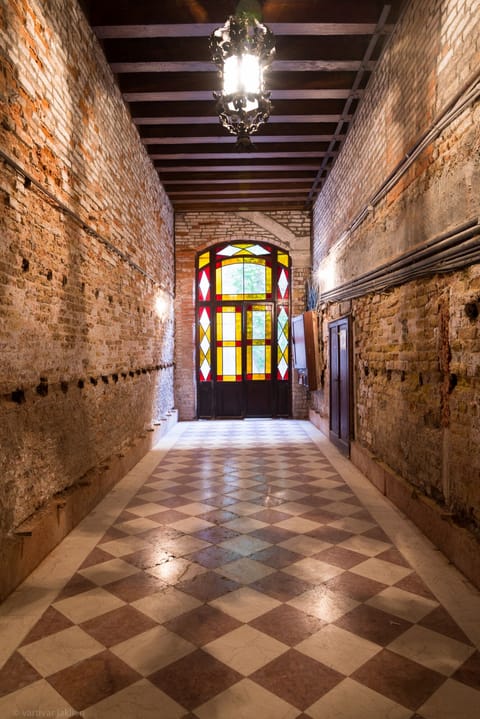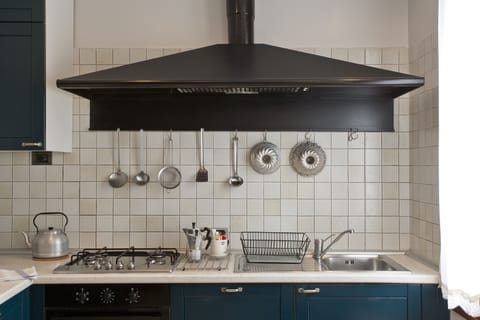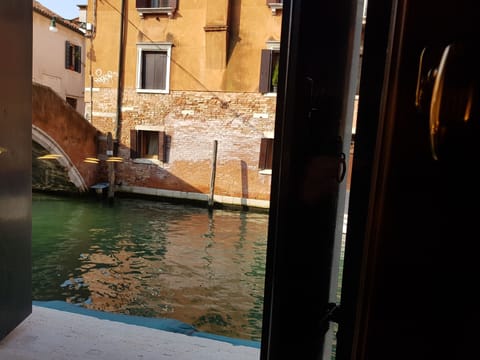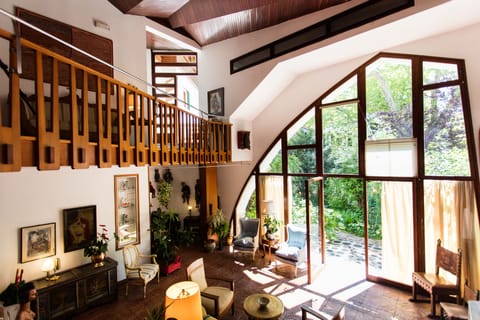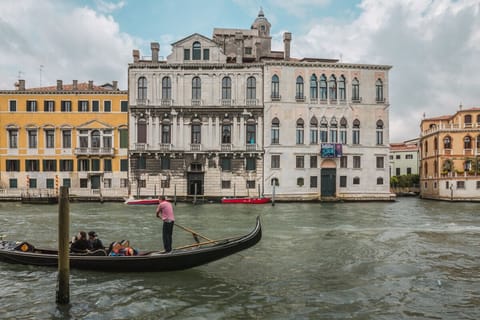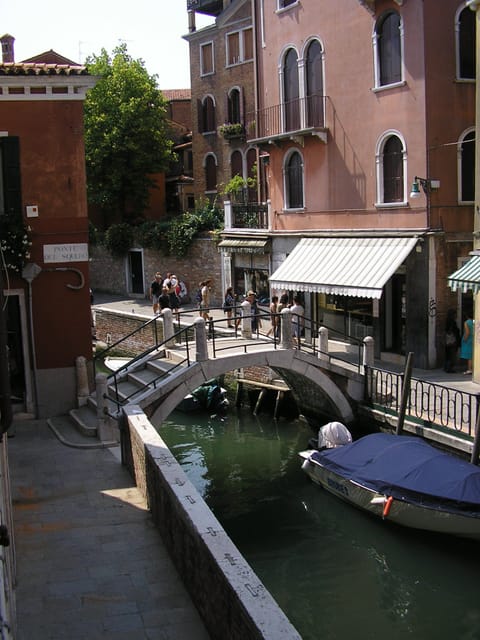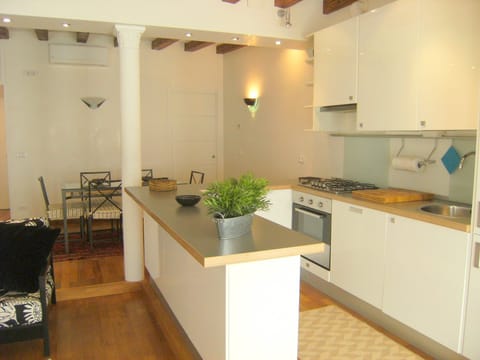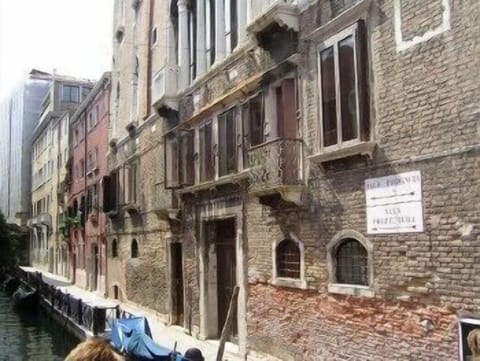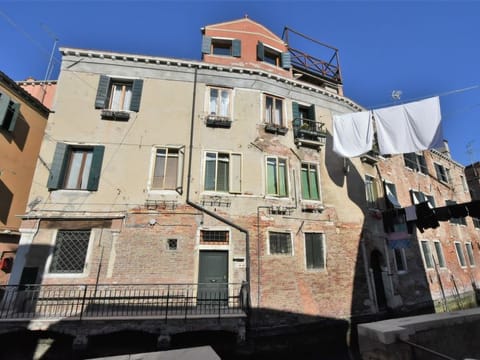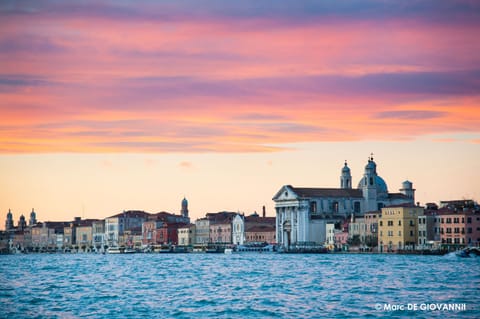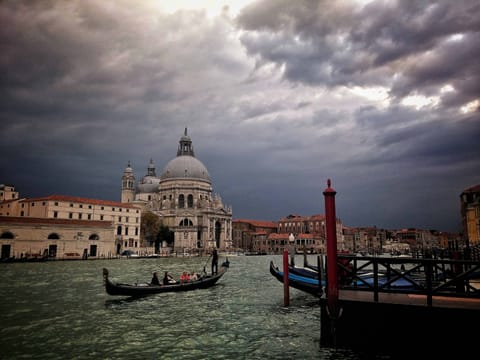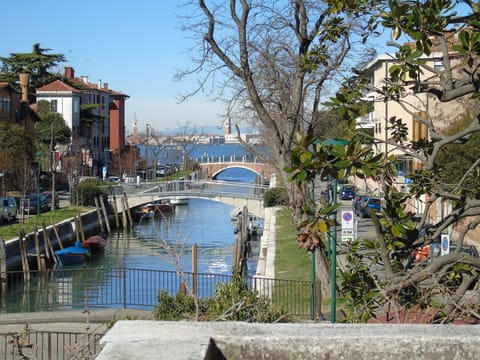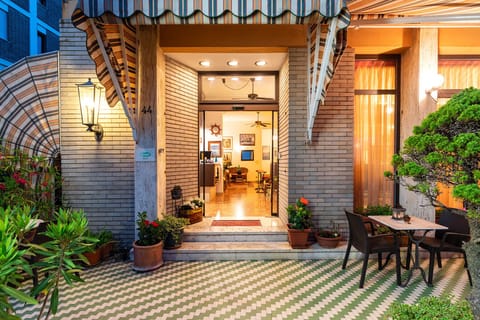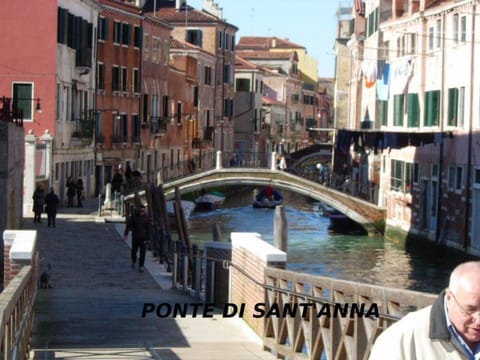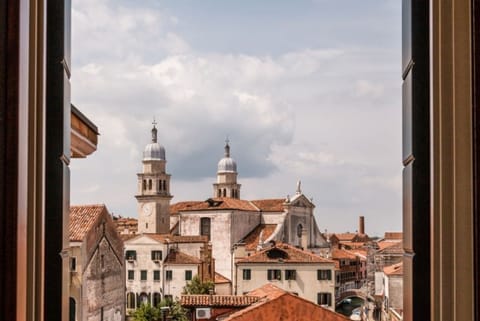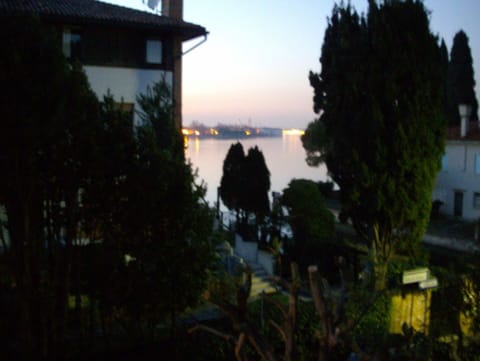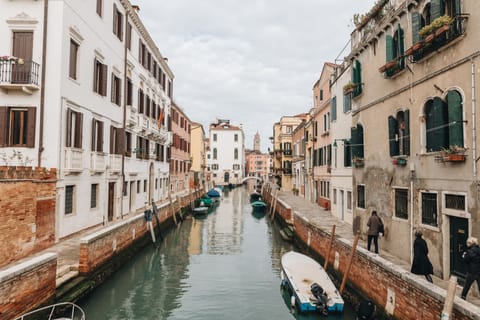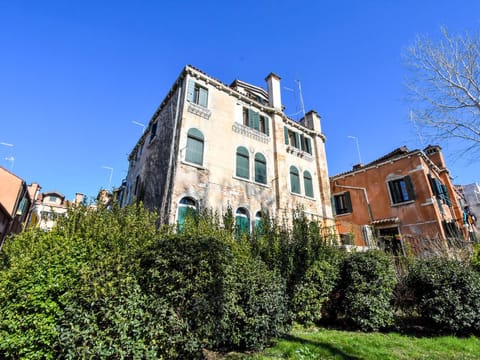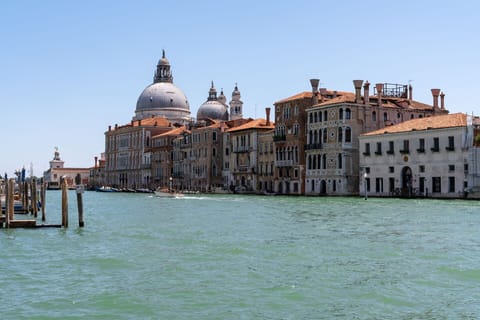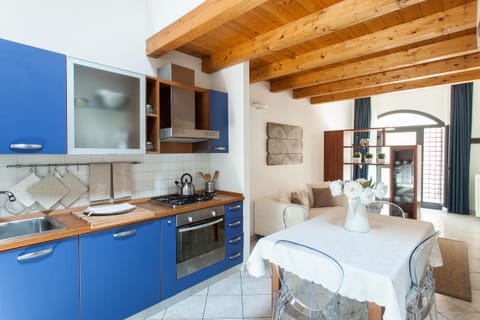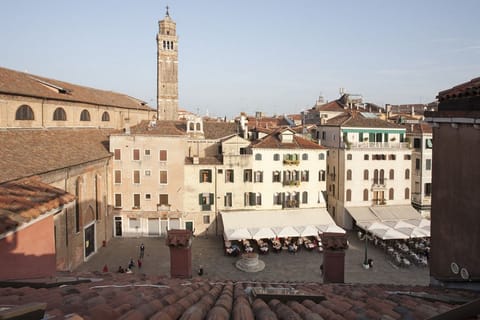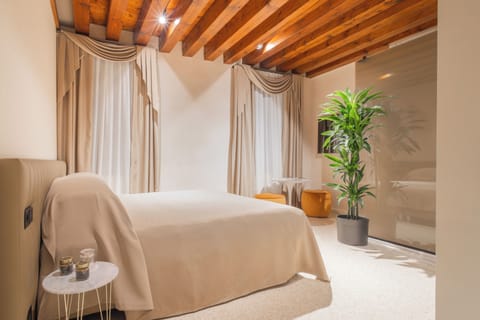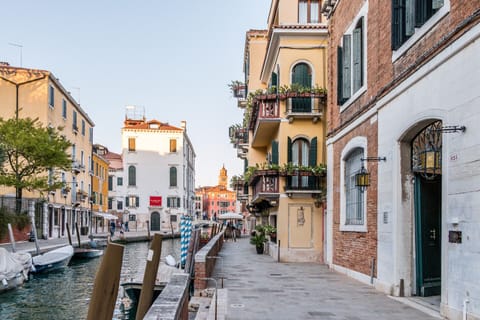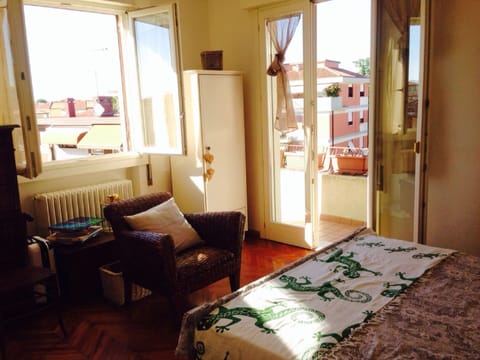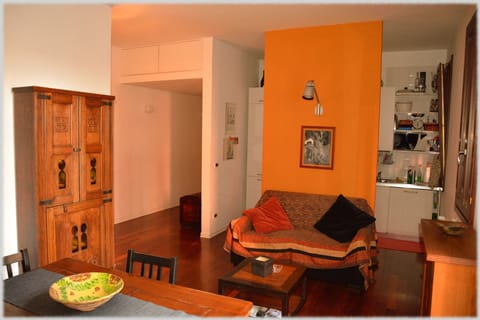Amazing, terrace great view and sunny in Castello authentic venetian area
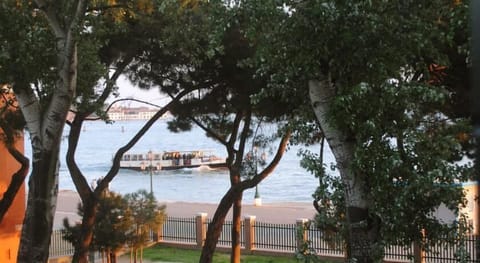
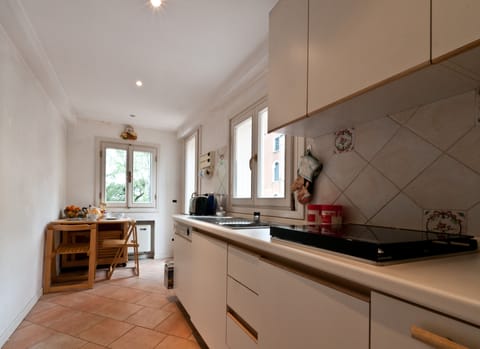
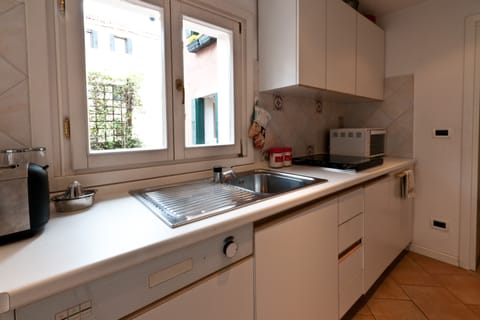
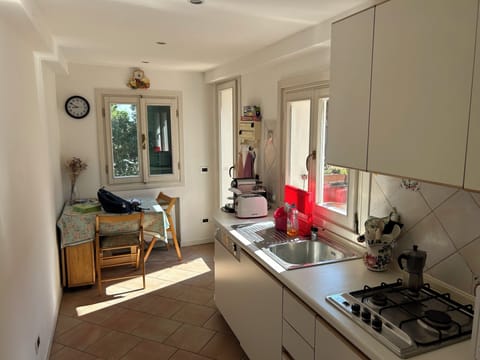
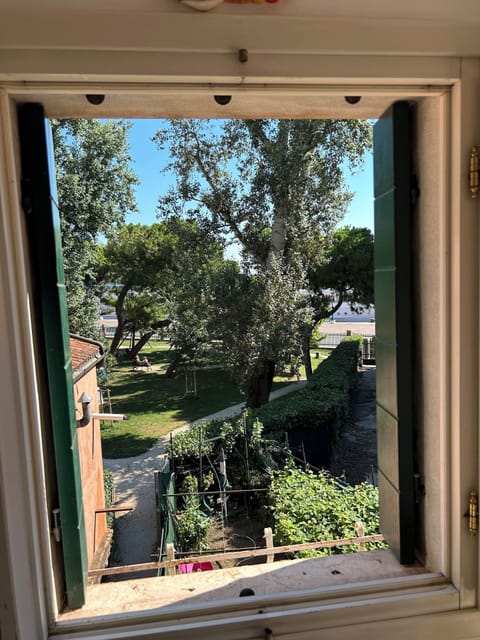
4.8
Outstanding(40 Reviews)Apartment in Lido di Venezia
4 guests · 2 bedrooms · 2 baths
Reasons to book
Guests love it hereGuests give this property a top rating
Free cancellationFull refund if you change your mind
Includes essentialsKitchen or Kitchenette, Air conditioner, Internet / Wifi and more
About this apartment rental
Wonderful apartment of 70 m2 with terrace in Castello with view, can accommodate up to 5 people. This apartment has living room, bedroom, kitchen, terrace, 2 bathrooms. A double sofa bed (130 cm) a double bed and a single in the bedroom
We also offer Rome and France!
The studio is located in the Sestiere de Castello. The largest of Venice's sestiere, located east of San Marco and Cannaregio, it stretches to the Arsenal, the Giardini and beyond.
Away from the hectic life of the Saint Marco sestiere, Castello is gradually transforming into a charming residential area of sleeping campi above which floats the linen hanging on the windows, shops with local customers, leading a peaceful life in the amidst its tranquil canals ..
To see in Castello:
• The Church of Santi Giovanni e Paolo (Zanipolo)
• The Arsenal
• The Naval Museum (Museo Storico Navale di Venezia)
• The Fondazione Querini Stampalia museum
• The museum of the Grimani Palace
• La Scuola di San Giorgio degli Schiavoni (paintings by Carpaccio)
• The Museo di Dipinti Sacri Byzanti (Collection of Byzantine icons)
• La Pieta church (frequented by Vivaldi)
• The Biennial Pavilions
• La Donna Partigiana, on the Riva Dei Partigiana, Giardini - a moving monument erected in memory of the women killed during the Second World War; the bronze statue of a reclining woman is submerged and only appears at low tide.
Brief history of Venice. The keys to Venice's economic domination of Italy in the Middle Ages were the insularity and naval ease of the Venetians, which had grown steadily for more than a millennium.
The region at the north-west end of the Adriatic Sea, where several rivers from the Alps flow, has been inhabited since Antiquity by fishermen, sailors and salt workers. This area was part of region X created by Auguste. This region was then named Venetia after the Venetians, an ancient Italic people integrated into the Roman Republic from the 2nd century BC. J-C; Aquileia - on dry land - was the important religious and port center.
The Gothic invasions of Alaric I and the Huns of Attila prompted local populations to take refuge in the marsh islands along the Adriatic Sea, near the Po Delta. According to the legend developed later by the Venetians to demonstrate the antiquity of their city and the distant origin of their freedom, Venice would have been founded on March 25, 421 in the islets of the rivus altus, which will become the Rialto.
In 452, a first establishment was founded by refugees from Padua and Aquileia. The region later fell into the Ostrogothic kingdom and was then reconquered with the rest of Italy by General Bélisaire, becoming a province of the Eastern Roman Empire under Justinian I.
The city of Venice was founded towards the end of the sixth century by inhabitants of neighboring regions, who came to take refuge in large numbers in the islands of the lagoon formed by the Po estuary after the invasion of northern Italy by the Lombards in 568. Indeed, this marshy area, difficult to access for keel vessels, had remained under the jurisdiction of the exarchate of Ravenna, province of the Eastern Roman Empire. It was therefore initially a refuge for Roman-Byzantine civilization, but as it developed, its autonomy increased to lead to independence.
Taking advantage of the antagonism between the Ravenna exarchate and the Lombards, the Venetians widened their political leeway and acquired local power embodied by the first duke or "doge", Paolucio Anafesto (697-717), character at the edge of legend and history. The city of Venice did not really become independent until after the withdrawal of the Byzantines from the Adriatic, shortly after the year 1000, when the kingdom of Hungary emerged. The city-state therefore relied on the sea to extend its power.
Venice did not have its own constitution. In fact, the definition of powers and the mechanism of government institutions came under customary law in Venice. The governmental decision-making bodies formed a pyramid of which the People's Assembly was the base and the Doge the summit. Between the two sat the Grand Council, the Forty and the Senate, then the Ducal Council. This political organization, the features of which emerged in the 13th century, continued until 17974. The quadrupling of naval power in the first third of the 15th century made the Arsenal of Venice the largest factory in the world, employing up to 16,000 people, behind a 25-hectare secret enclosure. Naval activity is driven by the dynamism of the Venetian business district.
The salt trade, then the commercial expansion towards the Eastern Mediterranean, led to a strong growth of the city. After the 4th crusade, which Venice diverted to Constantinople, the Republic seized the riches of the Byzantine Empire and constituted its own maritime empire made up of most of the Greek and Dalmatian islands. It completes it by conquering continental Dalmatia, Istria and a vast area between the Alps and the Po, including the cities of Bergamo, Brescia, Verona, Padua, Treviso and Udine. It comes into conflict with Genoa, its great rival in northern Italy and the Mediterranean. The climax of this struggle will be the Fourth Genoese War, otherwise known as the Chioggia War. Venice emerged victorious from the conflict, but very exhausted. The Treaty of Turin, in 1381, was not particularly advantageous to him: in spite of its victory, Venice had to give up territories and concede certain rights to its rival. She lost Treviso and Dalmatia which returned to the king of Hungary. However, it retained its institutions and its main colonies.
The city has armed a fleet of 6,000 galleys, allowing it to take risks, in the form of regular convoys, to reign over the Mediterranean Sea. The Rialto district is the first organized exchange, according to historian Fernand Braudel. The merchants there exchanged stakes in the Venetian galleys, auctioned according to the Incanto system of market galleys5. Venice thus becomes the most important port in the Mediterranean, surpassing Constantinople. He had to conquer land on the lagoon.
The decline began with Turkish progression in the Mediterranean, which gradually deprived it of all its Greek lands, with the exception of the Ionian Islands, and of its access to the outlets of the Silk Road, which was moreover very affected by the plague. black. Despite the victory over the Turks at Lepanto in 1571, the republic of Venice still lost its commercial importance due to the diversion of European trade to the oceans after the discovery of America.
Venice maintains its cultural influence, becoming the most elegant and refined European city of the 18th century, with a strong influence on art, architecture and literature.
Become politically an Italian state among others, Venice was annexed by Napoleon Bonaparte on May 12, 1797, during the first coalition. The invasion of the French put an end to nearly 800 years of independence. Napoleon was however perceived as a sort of liberator by the poor and Jewish population of Venice, an aristocratic republic where power and most of the wealth were monopolized by a few families. Napoleon removed the Ghetto barriers as well as the movement restrictions imposed on the Jews.
In 1797, by the Treaty of Campo-Formio, Napoleon delivered Venice and its territories to the Habsburgs in exchange for Belgium, then he took it back in 1805 to integrate it into the kingdom of Italy of which he was crowned king, before the city was not integrated into the Austrian Empire from 1815 to 1866. Austrian domination of Venice and the Veneto did not end until October 3, 1866 after its defeat of Sadowa against the Prusso-Italian alliance. Venice became an Italian provincial capital and one of the high places of world tourism.
After the First World War, Italy claimed the defeated whole of Venetian territories from Austria, but came up against Yugoslav claims and only obtained Istria, the city of Zara in Dalmatia, and the Treaty of Rapallo. islands of Veglia, Cherso and Lagosta. The resentment developed at that time contributed to Mussolini's later success. After the Second World War, Italy also lost these possessions to the benefit of Yugoslavia, keeping only Trieste which is not part of the former Venetian territories, but where the Italian-speaking populations expelled from Yugoslavia took refuge.
When you arrive at the apartment we will ask you for the cash payment of the "Tassa di Soggiorno" that the Municipality of Venice has recently established for private apartments for rent (currently 1.5 euros / person / night). You will receive a receipt for this payment.
We also offer Rome and France!
The studio is located in the Sestiere de Castello. The largest of Venice's sestiere, located east of San Marco and Cannaregio, it stretches to the Arsenal, the Giardini and beyond.
Away from the hectic life of the Saint Marco sestiere, Castello is gradually transforming into a charming residential area of sleeping campi above which floats the linen hanging on the windows, shops with local customers, leading a peaceful life in the amidst its tranquil canals ..
To see in Castello:
• The Church of Santi Giovanni e Paolo (Zanipolo)
• The Arsenal
• The Naval Museum (Museo Storico Navale di Venezia)
• The Fondazione Querini Stampalia museum
• The museum of the Grimani Palace
• La Scuola di San Giorgio degli Schiavoni (paintings by Carpaccio)
• The Museo di Dipinti Sacri Byzanti (Collection of Byzantine icons)
• La Pieta church (frequented by Vivaldi)
• The Biennial Pavilions
• La Donna Partigiana, on the Riva Dei Partigiana, Giardini - a moving monument erected in memory of the women killed during the Second World War; the bronze statue of a reclining woman is submerged and only appears at low tide.
Brief history of Venice. The keys to Venice's economic domination of Italy in the Middle Ages were the insularity and naval ease of the Venetians, which had grown steadily for more than a millennium.
The region at the north-west end of the Adriatic Sea, where several rivers from the Alps flow, has been inhabited since Antiquity by fishermen, sailors and salt workers. This area was part of region X created by Auguste. This region was then named Venetia after the Venetians, an ancient Italic people integrated into the Roman Republic from the 2nd century BC. J-C; Aquileia - on dry land - was the important religious and port center.
The Gothic invasions of Alaric I and the Huns of Attila prompted local populations to take refuge in the marsh islands along the Adriatic Sea, near the Po Delta. According to the legend developed later by the Venetians to demonstrate the antiquity of their city and the distant origin of their freedom, Venice would have been founded on March 25, 421 in the islets of the rivus altus, which will become the Rialto.
In 452, a first establishment was founded by refugees from Padua and Aquileia. The region later fell into the Ostrogothic kingdom and was then reconquered with the rest of Italy by General Bélisaire, becoming a province of the Eastern Roman Empire under Justinian I.
The city of Venice was founded towards the end of the sixth century by inhabitants of neighboring regions, who came to take refuge in large numbers in the islands of the lagoon formed by the Po estuary after the invasion of northern Italy by the Lombards in 568. Indeed, this marshy area, difficult to access for keel vessels, had remained under the jurisdiction of the exarchate of Ravenna, province of the Eastern Roman Empire. It was therefore initially a refuge for Roman-Byzantine civilization, but as it developed, its autonomy increased to lead to independence.
Taking advantage of the antagonism between the Ravenna exarchate and the Lombards, the Venetians widened their political leeway and acquired local power embodied by the first duke or "doge", Paolucio Anafesto (697-717), character at the edge of legend and history. The city of Venice did not really become independent until after the withdrawal of the Byzantines from the Adriatic, shortly after the year 1000, when the kingdom of Hungary emerged. The city-state therefore relied on the sea to extend its power.
Venice did not have its own constitution. In fact, the definition of powers and the mechanism of government institutions came under customary law in Venice. The governmental decision-making bodies formed a pyramid of which the People's Assembly was the base and the Doge the summit. Between the two sat the Grand Council, the Forty and the Senate, then the Ducal Council. This political organization, the features of which emerged in the 13th century, continued until 17974. The quadrupling of naval power in the first third of the 15th century made the Arsenal of Venice the largest factory in the world, employing up to 16,000 people, behind a 25-hectare secret enclosure. Naval activity is driven by the dynamism of the Venetian business district.
The salt trade, then the commercial expansion towards the Eastern Mediterranean, led to a strong growth of the city. After the 4th crusade, which Venice diverted to Constantinople, the Republic seized the riches of the Byzantine Empire and constituted its own maritime empire made up of most of the Greek and Dalmatian islands. It completes it by conquering continental Dalmatia, Istria and a vast area between the Alps and the Po, including the cities of Bergamo, Brescia, Verona, Padua, Treviso and Udine. It comes into conflict with Genoa, its great rival in northern Italy and the Mediterranean. The climax of this struggle will be the Fourth Genoese War, otherwise known as the Chioggia War. Venice emerged victorious from the conflict, but very exhausted. The Treaty of Turin, in 1381, was not particularly advantageous to him: in spite of its victory, Venice had to give up territories and concede certain rights to its rival. She lost Treviso and Dalmatia which returned to the king of Hungary. However, it retained its institutions and its main colonies.
The city has armed a fleet of 6,000 galleys, allowing it to take risks, in the form of regular convoys, to reign over the Mediterranean Sea. The Rialto district is the first organized exchange, according to historian Fernand Braudel. The merchants there exchanged stakes in the Venetian galleys, auctioned according to the Incanto system of market galleys5. Venice thus becomes the most important port in the Mediterranean, surpassing Constantinople. He had to conquer land on the lagoon.
The decline began with Turkish progression in the Mediterranean, which gradually deprived it of all its Greek lands, with the exception of the Ionian Islands, and of its access to the outlets of the Silk Road, which was moreover very affected by the plague. black. Despite the victory over the Turks at Lepanto in 1571, the republic of Venice still lost its commercial importance due to the diversion of European trade to the oceans after the discovery of America.
Venice maintains its cultural influence, becoming the most elegant and refined European city of the 18th century, with a strong influence on art, architecture and literature.
Become politically an Italian state among others, Venice was annexed by Napoleon Bonaparte on May 12, 1797, during the first coalition. The invasion of the French put an end to nearly 800 years of independence. Napoleon was however perceived as a sort of liberator by the poor and Jewish population of Venice, an aristocratic republic where power and most of the wealth were monopolized by a few families. Napoleon removed the Ghetto barriers as well as the movement restrictions imposed on the Jews.
In 1797, by the Treaty of Campo-Formio, Napoleon delivered Venice and its territories to the Habsburgs in exchange for Belgium, then he took it back in 1805 to integrate it into the kingdom of Italy of which he was crowned king, before the city was not integrated into the Austrian Empire from 1815 to 1866. Austrian domination of Venice and the Veneto did not end until October 3, 1866 after its defeat of Sadowa against the Prusso-Italian alliance. Venice became an Italian provincial capital and one of the high places of world tourism.
After the First World War, Italy claimed the defeated whole of Venetian territories from Austria, but came up against Yugoslav claims and only obtained Istria, the city of Zara in Dalmatia, and the Treaty of Rapallo. islands of Veglia, Cherso and Lagosta. The resentment developed at that time contributed to Mussolini's later success. After the Second World War, Italy also lost these possessions to the benefit of Yugoslavia, keeping only Trieste which is not part of the former Venetian territories, but where the Italian-speaking populations expelled from Yugoslavia took refuge.
When you arrive at the apartment we will ask you for the cash payment of the "Tassa di Soggiorno" that the Municipality of Venice has recently established for private apartments for rent (currently 1.5 euros / person / night). You will receive a receipt for this payment.
Amenities
Air conditioner
Kitchen or Kitchenette
Internet / Wifi
Parking
Laundry
Balcony or Patio
Dishwasher
Hot tub or spa
Map of Lido di Venezia
Reviews
4.8
Outstanding(40 Reviews)4.8
The property is well located in a quieter, less touristy part of Venice. The apartment is very well set up and equipped.
The terrace provides a great outlook to a park and water beyond. Nearby via Garibaldi has an excellent offering of cafes, bars and restaurants and a lively atmosphere. There is a good supermarket and easy access to water transport including the airport ferry.
The host was most helpful and communication was prompt and efficient. We greatly appreciated her generosity in allowing us to leave our bags in the property prior to our evening departure.
An excellent property with gracious hospitality from the host.
4.8
Fantastic location and great hosts! This apartment has everything required for a relaxing time in Venice. It is located in the quieter Castello neighborhood, but is close enough to everything you would want to see. A short walk from the Arsenale Vaporetto stop and a convenient walk to Piazza San Marco where many boat excursions leave from.
Access is safe and secure and the area is quiet at night. Dining options are plentiful down Via Garibaldi where you can also find a fresh fruit stand and a fully-stocked modern grocery store.
The apartment itself is cozy, but not small. The main bedroom has one large bed and a single while the living room has a comfortable pull-out couch. While the listing does not show a TV, there is a modern HDTV in the house should you want it. The internet connection is solid.
The balcony is amazing and provides beautiful views of the lagoon while overlooking a nice little park. The balcony also has a retractable cover to provide shade on hot sunny days.
Our host was incredibly helpful and responsive. I would stay again next time I visit the city.
4.8
Ganz Wunderbar!
4.8
We are very pleased with the apartment. It was very clean, excellent location, close to transportation and restaurants. The apartment had everything you might need, beautiful view from the spacious terrace.The host was friendly, helpful and accessible.
We can definitely recommend it.
4.8
Fantastic terrace overlooking a quiet park. Impossible to have a terrace over a park in Venice. Nearby neighborhood has many dining choices. Near St Mark’s but without the crazy crowds. Perfect!
4.8
Tolle Lage
Top Lage, schöne ruhige Wohnung.
4.8
Comfortable apartment with a beautiful view
Comfortable apartment with a beautiful view, in a nice neighbourhood. Very agreeable terrace. Shops and restaurants nearby. Nice communication with the owners.
4.8
Biennale
Sehr gut gelegen, tolle Umgebeung
4.8
Amazing Location!!
We have visited Venice many times and this is the best location we have stayed in. It is close enough to all the main attractions but situated in a more residential area so you can retreat to your own neighbourhood after a busy day exploring. It is right off of the Via Garibaldi which is a fabulous wide street full of fantastic restaurants and all the amenities (great bakery, fruit stand, grocery store etc.). The property itself is well kept up, lots of space, good internet, and most amazing of all, a lovely terrace which overlooks a park and the lagoon - we had breakfast out there every morning!
4.8
Cinq étoiles
Nous sommes très satisfaits de notre séjour dans cet appartement charmant avec sa jolie vue de la terrasse, et aussi particulièrement de l'accueil de Luna...
4.8
Angenehmes Wohnen in Venedig
Die Schlüsselübergabe und „Vorstellung“ des Apartments verliefen reibungslos und freundlich. Die Lage ist super, nah zur Biennale, zwischen den Haltestellen Arsenale und Giardini. Die Aufteilung der Wohnung ist prima, alles ist vorhanden und die Terrasse ist ein Highlight!
Die Via Garibaldi bietet Geschäfte, Restaurants und Cafés, die überwiegend von Einheimischen besucht werden.
Wir kommen gerne wieder!
4.8
Location Venise idéale pour nous !
Location très agréable très propre et idéalement située
Nous relouerons volontiers !
4.8
mary
Gute Lage, alles bestens
4.8
Un appartement confortable et très bien situé.
4.8
Très belle terrasse et vue sur la lagune
Un appartement confortable et très bien situé.
4.8
Tolle Lage, schöne Wohnung, Venedig JETZT!!!
Wir wurden nett begrüßt und erhielten Antworten auf alle Fragen. Die Wohnung war sehr sauber (und wir sind eher pingelig) und entspricht genau der Beschreibung. Für 4 Personen ist sie zur Schlechtwetterzeit evtl. nicht so gut, aber bei gutem Wetter ist auf der schönen Terrasse reichlich Platz.Ein Sonnendach kann man auch entfalten. Super Aussicht auch von Küche und Wohnzimmer aus. Viele Fenster, gut zu lüften. Wir haben uns rundum wohl gefühlt!!
Wir haben auch nicht feststellen können, dass irgendetwas defekt ist. Grundausstattung an Gewürzen, Tee und Kaffe vorhanden. Adapter für deutsche Stecker sind ebenfalls
vorhanden.
Zwei gute Bäcker in 50 m Entfernung, gute und für Venedig auch nicht zu teure Lokale in zwei Minuten erreichbar bzw. direkt um die Ecke, guter Coop in 200m - alles praktisch. Hier sind hauptsächlich Einheimische unterwegs. Wie es so ohne Corona ist, weiß ich natürlich nicht. Aber wenn ihr in Venedig ohne Schlange stehen und Drängeln Urlaub machen wollt, ist es genau jetzt die Gelegenheit.
Anbindung an Vaporetto bzw. Allilaguna vom Flughafen in weniger als 5 Minuten.
In 2 Minuten ist man in den Biennale Gärten.
Außerdem war die Wohnung schön ruhig, wir haben gut geschlafen!
Insgesamt absolut empfehlenswert.
Die Vermieter sind sehr kulant und haben uns die 2 Tage, die wir früher abreisen mussten, sogar erstattet!
4.8
Mitten im italienischen Leben
Die Wohnung liegt abseits des Tourismus-Hotspots Markusplatz, aber trotzdem nur zwei Vaporetto-Stationen oder wenige Brücken von ihm entfernt.
Auf der großzügigen Terrasse lassen sich durch die Bäume des Parks beim Frühstück Jogger, Vaporettos und Lido-Fähren zählen.
Das Highlight der Wohnung ist aber seine Lage in unmittelbarer Nähe der Via Garibaldi. Eine für venezianische Verhältnisse ungewöhnlich breite Straße mit prallem Leben. Reichlich Restaurants, Bars natürlich alle mit großen Außenbereichen. Außerdem Supermarkt, Weinhändler, Bäckereien, Obst- und Gemüsehändler, Spezialitätengeschäfte alles da in der Via Garibaldi.
Und in fünf Minuten Fußweg ist man am Eingang des Bienale-Geländes.
Die Wohnung ist für 2 Personen optimal. Mit 4 Erwachsenen kann es im Wohnzimmer schon ein bisschen eng werden.
Aber wer will bei der Terrasse und der Umgebung unnötig lang im Wohnzimmer rumlungern?
4.8
Schöne Lage
Schöne Wohnung, gut ausgestattet.
4.8
Schöne Ferien
Die Wohnung ist sehr gemütlich und an wunderbarer Lage.
Die riesige alte Stereoanlage (auf Bild im Internet funktioniert nicht.) Also nicht, wie ich, eigene CD's mitschleppen.
Ansonsten war ich happy.
4.8
Great property and a great location on the Riva. Giuseppe Garibaldi is also a great street with 8-10 restaurants and wine bars within two blocks of your street.
The property is perfect with an amazing terrazzo, kitchen, washing machine, and two bathrooms
4.8
Venice terrazzo
Great property and a great location on the Riva. Giuseppe Garibaldi is also a great street with 8-10 restaurants and wine bars within two blocks of your street.
The property is perfect with an amazing terrazzo, kitchen, washing machine, and two bathrooms
4.8
Emplacement exceptionnel, appartement avec terrasse agréable
Cet appartement à proximité de l'arsenal et des jardins de la biennale est idéalement placé pour qui cherche une Venise authentique. Calme, clair, confortable, avant-dernier étage, et terrasse très appréciée donnant sur un beau jardin public (fermé la nuit), la lagune est juste derrière les grands arbres. Deux inconvénients cependant : la climatisation (efficace) est bruyante, et le compteur électrique saute facilement.
4.8
Très bon séjour. Appartement bien équipé et très propre.
Appartement très bien situé avec une agréable terrasse,Et très bien équipé.
Seul petit bémol la climatisation est un peu faible mais avec des moustiquaires cela serait parfait. Pas de télévision mais très bonne wifi.
Appartement à recommander.
Nous y reviendrons avec plaisir.
Isabelle L.
4.8
Excellent séjour
Appartement idéalement situé dans un quartier typiquement vénitien et qui bénéficie d'une très agréable terrasse qui ajoute encore à son charme. Merci
4.8
Super !
Très belle location, très bien située, équipées, belle vue, calme!
Produits de première nécessité à disposition (café, sucre, farine, huile, vinaigre).
Commerces et restaurants à proximité !
Quartier qui à su garder son charme, et son authenticité !
La plupart des touristes n'ont pas le courage de marcher jusque là.
Très beaux jardins à proximité !
Je recommande vivement !
4.8
Great location, nice terrace, plenty of space.
Attentive owners.
Needs small dining table in living rm.
Equipment, esp plumbing in poor shape, in particular: broken shower head, shower hose, shower bracket, 2 broken toilet seats, faulty flush, broken electric kettle, broken bin (owners kindly replaced bin on request).Lots of old leftover food, In particular fridge needs to be left empty and clean.
4.8
Great location - nice terrace - poor equipment/maintenance of facilities
Great location, nice terrace, plenty of space.
Attentive owners.
Needs small dining table in living rm.
Equipment, esp plumbing in poor shape, in particular: broken shower head, shower hose, shower bracket, 2 broken toilet seats, faulty flush, broken electric kettle, broken bin (owners kindly replaced bin on request).Lots of old leftover food, In particular fridge needs to be left empty and clean.
4.8
Quiet location
This is a great home base to explore Venice from. There are lots of amenities close by including places or eat and/or have a drink, grocery store, fruit/veggie stand, and a speciality Italian shop where you can get some good cheese. It was nice to have a balcony on which to enjoy a meal. While the balcony could get a little warm under the sunny July skies, it has a shade that helps to make it usable at any time of the day. The kitchen was sufficient for cooking. We actually cooked three evening meals during the week we were there. After spending much of the day walking in the full sun it was very nice to come back to an air-conditioned apartment. The internet works well. The electrical system is a little sensitive to running too many things at the same time. While we managed to cause the power to good off almost immediately as I need to wash clothes, it was easy to get going again. We easily managed not to have the same issue again.
4.8
gute Lage, tolle Terrasse
Die Wohnung lebt von der sehr guten Lage und der tollen Terrasse. Arsenale Anleger gleich ums Eck, schöne Restaurants in der via Garibaldi ebenso. Es ist sehr schön auf der Terrasse zu sitzen und in die Lagune zu blicken. Alles andere passt auch.
4.8
The flat was as described. The terrace has a large table and views over a small park with a glimpse of the lagoon and was a lovely place to have breakfast. The flat has two bathrooms, which wasn't clear to me from the description, and sleeps 5 in total: a double bed and a single bed in one large bedroom and a double sofa-bed in the sitting room. The double bed was rather hard (the least good thing about the flat). The kitchen was well equipped, but the table only comfortably seats three people. NB: there was no TV in the flat.
The location is extremely quiet, down an alley from the Via Garibaldi which has lots of popular bars and restaurants. There's a bakery and a good fruit and veg stall in the immediate area. The supermarket is about 5 minutes walk but rather hard to find - the easiest way is to follow someone with a shopping trolley! It takes about 10 minutes to walk along the quayside to St Mark's Square and the nearest vaporetto stop is only a couple of minutes away. When we arrived the owner's father met us at the vaporetto and took us to the flat.
We can unhesitatingly recommend this flat.
4.8
The flat was as described. The terrace has a large table and views over a small park with a glimpse of the lagoon and was a lovely place to have breakfast. The flat has two bathrooms, which wasn't clear to me from the description, and sleeps 5 in total: a double bed and a single bed in one large bedroom and a double sofa-bed in the sitting room. The double bed was rather hard (the least good thing about the flat). The kitchen was well equipped, but the table only comfortably seats three people. NB: there was no TV in the flat.
The location is extremely quiet, down an alley from the Via Garibaldi which has lots of popular bars and restaurants. There's a bakery and a good fruit and veg stall in the immediate area. The supermarket is about 5 minutes walk but rather hard to find - the easiest way is to follow someone with a shopping trolley! It takes about 10 minutes to walk along the quayside to St Mark's Square and the nearest vaporetto stop is only a couple of minutes away. When we arrived the owner's father met us at the vaporetto and took us to the flat.
We can unhesitatingly recommend this flat.
4.8
Lovely appartment, great location
The flat was as described. The terrace has a large table and views over a small park with a glimpse of the lagoon and was a lovely place to have breakfast. The flat has two bathrooms, which wasn't clear to me from the description, and sleeps 5 in total: a double bed and a single bed in one large bedroom and a double sofa-bed in the sitting room. The double bed was rather hard (the least good thing about the flat). The kitchen was well equipped, but the table only comfortably seats three people. NB: there was no TV in the flat.
The location is extremely quiet, down an alley from the Via Garibaldi which has lots of popular bars and restaurants. There's a bakery and a good fruit and veg stall in the immediate area. The supermarket is about 5 minutes walk but rather hard to find - the easiest way is to follow someone with a shopping trolley! It takes about 10 minutes to walk along the quayside to St Mark's Square and the nearest vaporetto stop is only a couple of minutes away. When we arrived the owner's father met us at the vaporetto and took us to the flat.
We can unhesitatingly recommend this flat.
4.8
Lovely appartment, great location
The flat was as described. The terrace has a large table and views over a small park with a glimpse of the lagoon and was a lovely place to have breakfast. The flat has two bathrooms, which wasn't clear to me from the description, and sleeps 5 in total: a double bed and a single bed in one large bedroom and a double sofa-bed in the sitting room. The double bed was rather hard (the least good thing about the flat). The kitchen was well equipped, but the table only comfortably seats three people. NB: there was no TV in the flat.
The location is extremely quiet, down an alley from the Via Garibaldi which has lots of popular bars and restaurants. There's a bakery and a good fruit and veg stall in the immediate area. The supermarket is about 5 minutes walk but rather hard to find - the easiest way is to follow someone with a shopping trolley! It takes about 10 minutes to walk along the quayside to St Mark's Square and the nearest vaporetto stop is only a couple of minutes away. When we arrived the owner's father met us at the vaporetto and took us to the flat.
We can unhesitatingly recommend this flat.
4.8
Quiet, good location, pleasant terrace
The flat was as described. The terrace has a large table and views over a small park with a glimpse of the lagoon and was a lovely place to have breakfast. The flat has two bathrooms, which wasn't clear to me from the description, and sleeps 5 in total: a double bed and a single bed in one large bedroom and a double sofa-bed in the sitting room. The double bed was rather hard (the least good thing about the flat). The kitchen was well equipped, but the table only comfortably seats three people. NB: there was no TV in the flat.
The location is extremely quiet, down an alley from the Via Garibaldi which has lots of popular bars and restaurants. There's a bakery and a good fruit and veg stall in the immediate area. The supermarket is about 5 minutes walk but rather hard to find - the easiest way is to follow someone with a shopping trolley! It takes about 10 minutes to walk along the quayside to St Mark's Square and the nearest vaporetto stop is only a couple of minutes away. When we arrived the owner's father met us at the vaporetto and took us to the flat.
We can unhesitatingly recommend this flat.
4.8
Veronique was extremely helpful with the booking of the apartment. Questions were answered quickly. We had a wonderful week and loved the apartment and especially the terrace. The apartment is very quiet and the AC is really a big bonus. We also loved the surroundings and the fact that it is outside of the most crowded areas but still it is only a 10-15 minutes walk to piazza San Marco. There are a number of small shops, bars and restaurants on the Garibaldi street and you will find most of what you need close by. I truely recommed the apartment to anybody who want to see more of Venice than just the city center and be a little closer to Venetian everyday life.
4.8
Perfect stay in Venice!
Veronique was extremely helpful with the booking of the apartment. Questions were answered quickly. We had a wonderful week and loved the apartment and especially the terrace. The apartment is very quiet and the AC is really a big bonus. We also loved the surroundings and the fact that it is outside of the most crowded areas but still it is only a 10-15 minutes walk to piazza San Marco. There are a number of small shops, bars and restaurants on the Garibaldi street and you will find most of what you need close by. I truely recommed the apartment to anybody who want to see more of Venice than just the city center and be a little closer to Venetian everyday life.
FAQs
How much does this apartment cost compared to others in Lido di Venezia?
The average price for a rental in Lido di Venezia is $172 per night. This rental is $193 above the average.
Is parking included with this apartment?
Yes, parking is listed as an amenity at Amazing, terrace great view and sunny in Castello authentic venetian area. For more information, we encourage you to contact the property about where to park.
Is there a pool at this apartment?
We didn’t find pool listed as an amenity for this apartment. It may be worth double checking if a pool is important for your stay.
Is Amazing, terrace great view and sunny in Castello authentic venetian area pet friendly?
Unfortunately, this apartment is not pet-friendly. Try searching again and filter for "Pets Allowed"
What amenities are available at Amazing, terrace great view and sunny in Castello authentic venetian area?
We found 8 amenities for this rental. This includes air conditioner, kitchen or kitchenette, internet / wifi, parking, and laundry.
Explore similar vacation rentals in Lido di Venezia
Explore all rentals in Lido di VeneziaLido di Venezia travel inspiration
Read our blogGuides
Top Things to Do in Miami: From Beaches to Culture
Guides
The Best Things to Do in Orlando: Attractions, Food, and Family Fun
Guides
Things to Do in Galveston, Texas
Guides
Top Things to Do in Myrtle Beach
Guides
Ski Trip Packing List: What to Bring Skiing or Snowboarding
Trends
VacationRenter Holiday Travel Trends 2023
Featured Rentals
Architectural Vacation Rentals: Experience the Beauty of Unique Properties
Featured Rentals
Sustainable and Eco-Friendly Vacation Rentals Around the World
